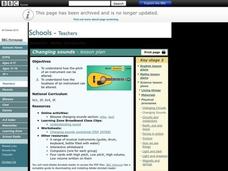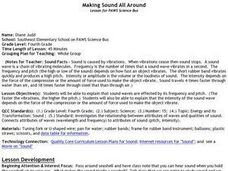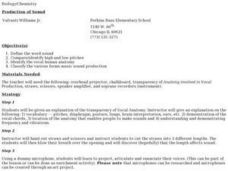Curated OER
Observing Sound
Second graders study the five senses and the link between pictures and sound. In this sound lesson students discover that sound is vibration, it is described by volume and pitch.
Curated OER
Boombox Classroom: Melody II
In this music worksheet, students draw the shape of melodies. They represent low and high pitches by drawing lines that are low and high in elevation. They listen to a song, and circle the picture that represents what they heard in the...
Curated OER
Changing Sounds
Students listen to sound. In this changing sounds activity, students play instruments to help them hear volume and pitch. Students use the interactive whiteboard to experiment how change can make sounds go higher or lower.
Curated OER
Animal Challenge 2
In this pitch worksheet, students examine a list of 6 animals. Students record the size of each animal as big or small and the sounds they make as high or low.
Curated OER
Making Sound All Around
Fourth graders examine how sound waves are effected by frequency and pitch. They conduct experiments using tuning forks, rubber bands, balloons, and water, and answer questions about the experiments.
Urbana School District
Sound
Beautiful music doesn't just write itself, but if you ever feel bad about procrastinating, remember that Mozart wrote the overture to Don Giovanni the morning it premiered. Introduce young scientists to the elements of sound including...
Perkins School for the Blind
Modified Kickball
Kickball is a classic recess game that everybody should play at least once. Included here is a wonderful set of instructions that describe how you can modify the game to make it accessible to children with low or no visual ability....
Curated OER
Small and Tall
Learners demonstrate pitch direction by using movement and visual representation.
Curated OER
Vibrating Objects Produce Sound
Students use many different materials and resources in order to study and identify sounds that are loud or soft, high or low, pleasant or unpleasant.
Curated OER
Music Elements For Second Grade
Second graders are exposed to a variety of attributes of melody in seven lessons of this unit. the notation in treble clef, pitch, and the movements of the melody are presented in these lessons.
Curated OER
Vocal Exploration
Students explore vocal anatomy. In this biology/music lesson, students first learn vocabulary associated with the voice and body. They then use straws, microphones and recorders to differentiate between high and low pitches and...
Curated OER
Elements of Music
In this music worksheet, 7th graders fill in the blanks in 7 sentences that describe the elements of music such as tempo, pitch, decay, and duration. They use the words from a word bank at the bottom of the page. They make a word search...
San Francisco Symphony
The American Five - Pentatonic scales in early American melodies
Through vocal warm-ups and exercises, budding musicians will attempt to grasp the five pentatonic scales, commonly used in early American songs. They'll sing and work to identify the pitch, tone, melody, and scales being expressed in the...
Curated OER
Sound Observations
Learners explore sound waves by conducting an experiment in class. In this sound frequency lesson, students utilize a tuning fork in class and identify which objects in class create different sound pitches on the fork. Learners conduct...
Curated OER
Sound: What is Sound and how does it travel?
Students learn that vibration makes different types of sounds. For this sound lesson, students perform experiments to understand vibrations and high and low pitch sounds. Students learn that sound travels differently through different...
Curated OER
What is Sound?
Second graders discuss sound and describe them. In this investigative activity students observe sound through their eyes, bodies and ears.
Discovery Education
Sonar & Echolocation
A well-designed, comprehensive, and attractive slide show supports direct instruction on how sonar and echolocation work. Contained within the slides are links to interactive websites and instructions for using apps on a mobile device to...
Curated OER
The Choir
In this music worksheet, students read an excerpt about the choir, the oldest of all musical groups. They identify that human voices vary in pitch, some high and some low, making it possible to sing harmonies in different layers.
Curated OER
Tune Up Your Ears!
Students discuss meaning of pitch, listen for different sounds in classroom, hallway, and outdoors, and listen to sounds played on piano and on computer to determine high or low pitch.
Curated OER
The Sorcerer's Apprentice
Third graders listen to "The Sorcerer's Apprentice". Using the music, they identify the high and low parts in the orchestal composition. They compare the elements of a story to the piece of music and respond to the music and state how...
Curated OER
Sound
In this sound worksheet, students understand how sound is created and how the human ear "hears." Students compare the frequency, amplitude, and speed of sound. Then students complete 10 matching, 7 fill in the blank, and 11 short answer...
Curated OER
Accuracy of Measurements
For this accuracy of measurements worksheet, students solve and complete 3 different types of word problems. First, they find the largest area of pitch in the problem described. Then, students write down an inequality to show the range...
Curated OER
Musical Instruments - Woodwinds
Students assemble and examine typical European orchestral woodwind instruments, determine how the instruments change pitch, identify common orchestral woodwind instruments by sound, and research a non-Euro-centric woodwind instrument in...
Curated OER
Sounds Like Science - Drums
Young scholars see that understanding how sound is produced makes it possible for us to manipulate it so we can decrease the number of unpleasant sounds we encounter. They make a drum to explore the concepts of force, pitch and volume.

























